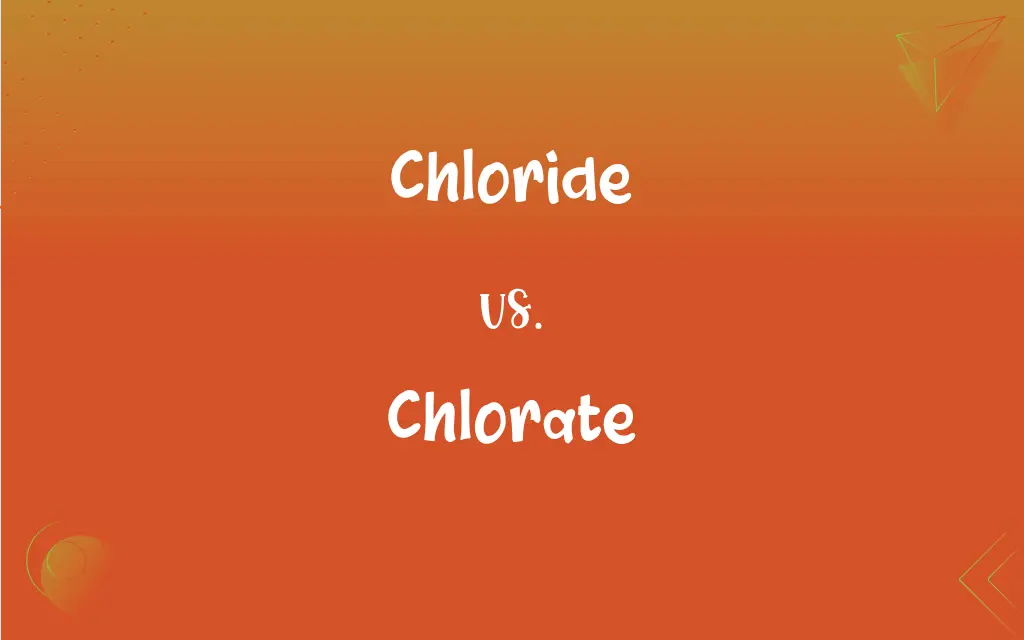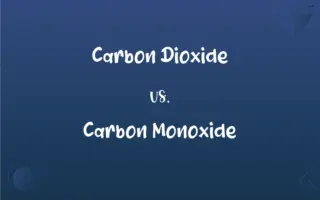Chloride vs. Chlorate: What's the Difference?
Edited by Aimie Carlson || By Harlon Moss || Updated on October 24, 2023
Chloride is an ion with the formula Cl⁻, while chlorate is an ion with the formula ClO₃⁻.

Key Differences
Chloride is an anion that consists of a single chlorine atom. It is the negatively charged counterpart to the element chlorine, which is found in its elemental state as a diatomic molecule, Cl₂. On the other hand, chlorate is a polyatomic ion consisting of one chlorine atom and three oxygen atoms. Chlorate is a member of the halate series, where halogens bond with oxygen in various ratios. While chloride ions are commonly found in nature as a result of the dissolution of salt in water, chlorate ions are typically synthesized in labs or produced through specific chemical reactions.
In terms of charge, the chloride ion carries a negative one (-1) charge, indicating it has gained an extra electron. Chlorate, in its common form, has a charge of negative one (-1) as well, but the distribution of its electrons among its four constituent atoms (one chlorine and three oxygens) is different. The presence of oxygen in chlorate gives it distinct chemical properties compared to the chloride ion.
Both chloride and chlorate ions are used in various industrial and chemical applications. Chloride is often associated with sodium to form table salt (sodium chloride) and is essential for life, playing a key role in the biology of all living organisms. Chlorate, however, is commonly used in herbicides, disinfectants, and as an oxidizing agent. It's worth noting that while both ions contain chlorine, their chemical behavior, due to the presence or absence of oxygen, can be quite distinct.
In terms of safety and environmental concerns, while chloride ions are generally safe and are an essential dietary element, chlorate can be harmful. Chlorate is a strong oxidizing agent and can pose risks if ingested or inhaled in large amounts. The two should not be confused, as their implications for health and the environment can vary widely based on their distinct chemical properties.
Comparison Chart
Formula
Cl⁻
ClO₃⁻
ADVERTISEMENT
Constituent Atoms
1 Chlorine atom
1 Chlorine and 3 Oxygen atoms
Charge
-1
-1
Common Use
Found in table salt (sodium chloride)
Used in herbicides & disinfectants
Health Implications
Essential dietary element
Harmful if ingested in large amounts
Chloride and Chlorate Definitions
Chloride
Chloride is essential for maintaining fluid balance in the body.
Electrolyte imbalances can lead to a deficiency or excess of chloride in the body.
ADVERTISEMENT
Chlorate
Chlorate is a strong oxidizing agent.
Many herbicides contain chlorate to kill unwanted plants.
Chloride
Chloride is an anion with the formula Cl⁻.
Sodium chloride is a common salt used in cooking.
Chlorate
Chlorate is a polyatomic ion with the formula ClO₃⁻.
Potassium chlorate is often used in fireworks due to its oxidizing properties.
Chloride
Chloride results from the dissociation of salts.
When table salt dissolves in water, it splits into sodium and chloride ions.
Chlorate
Chlorate contains one chlorine and three oxygen atoms.
The presence of three oxygen atoms gives chlorate its chemical properties.
Chloride
Chloride is found naturally in many foods and water sources.
Seawater contains a high concentration of chloride ions.
Chlorate
Chlorate can be synthesized in laboratories.
Scientists often produce chlorate through specific chemical reactions.
Chloride
Chloride is the negatively charged counterpart of chlorine.
When chlorine gas reacts with sodium, it forms sodium chloride.
Chlorate
Chlorate can be harmful when ingested or inhaled.
It's essential to handle chemicals containing chlorate with care.
Chloride
Univalent anionic chlorine, or a compound of chlorine, especially a binary compound of chlorine with a more electropositive element.
Chlorate
The anionic univalent group ClO3 derived from chloric acid, or a compound containing this group.
Chloride
(chemistry) any salt of hydrochloric acid, such as sodium chloride, or any binary compound of chlorine and another element or radical
Chlorate
(chemistry) Any salt of chloric acid.
Chlorates are powerful oxidizing agents.
Chloride
A binary compound of chlorine with another element or radical; as, chloride of sodium (common salt).
Chlorate
A salt of chloric acid; as, chlorate of potassium.
Chloride
Any compound containing a chlorine atom
Chlorate
Any salt of chloric acid
Chloride
Any salt of hydrochloric acid (containing the chloride ion)
FAQs
What is chloride in simple terms?
Chloride is a negatively charged ion with the formula Cl⁻.
Is chloride essential for the human body?
Yes, chloride is vital for maintaining fluid and electrolyte balance.
Can chlorate be found in nature?
While chlorate can form in specific natural conditions, it's mostly synthesized in labs.
What's the health implication of consuming too much chloride?
Excessive chloride can disrupt electrolyte balance, though it's rare with a regular diet.
What's a common use of chloride in the industry?
Chloride, as in sodium chloride, is widely used in various industries, including food and medicine.
Is chloride the same as table salt?
No, table salt is sodium chloride, where chloride is one component.
How can one distinguish between chloride and chlorate in a substance?
Chemical tests and spectral analysis can differentiate between the two ions.
Are chloride and chlorine the same thing?
No, chlorine is a diatomic gas (Cl₂), while chloride is its anionic form (Cl⁻).
Are both chloride and chlorate derived from chlorine?
Yes, both are derived from chlorine, but they have different structures and properties.
Is there a connection between chlorate and explosives?
Yes, chlorate is a strong oxidizer and can be used in certain explosive mixtures.
How is chlorate different from chloride?
Chlorate is a polyatomic ion with the formula ClO₃⁻, while chloride is Cl⁻.
Can chlorate be harmful to the environment?
Yes, especially when it's used in large amounts, as in some herbicides.
How are chloride levels measured in the body?
Through blood tests that measure serum chloride concentrations.
Do foods naturally contain chloride?
Yes, many foods, especially processed ones, contain chloride, often as part of salt.
Can chlorate be used as a fertilizer?
No, chlorate is a herbicide and can harm plants. It's not used as a fertilizer.
Are there any similarities between chloride and chlorate?
Both contain chlorine atoms, but their properties and uses differ due to their structures.
How is chlorate produced in labs?
Through the electrolysis of chloride solutions or specific chemical reactions.
Are chloride and chlorate used in water purification?
Chloride, in the form of chlorine, is often used for disinfection. Chlorate can form as a byproduct.
Why is chlorate considered an oxidizing agent?
Due to its ability to donate oxygen atoms in reactions, making it a strong oxidizer.
Can chlorate be used for medicinal purposes?
While chlorate has some disinfectant properties, its potential toxicity limits its medicinal use.
About Author
Written by
Harlon MossHarlon is a seasoned quality moderator and accomplished content writer for Difference Wiki. An alumnus of the prestigious University of California, he earned his degree in Computer Science. Leveraging his academic background, Harlon brings a meticulous and informed perspective to his work, ensuring content accuracy and excellence.
Edited by
Aimie CarlsonAimie Carlson, holding a master's degree in English literature, is a fervent English language enthusiast. She lends her writing talents to Difference Wiki, a prominent website that specializes in comparisons, offering readers insightful analyses that both captivate and inform.































































